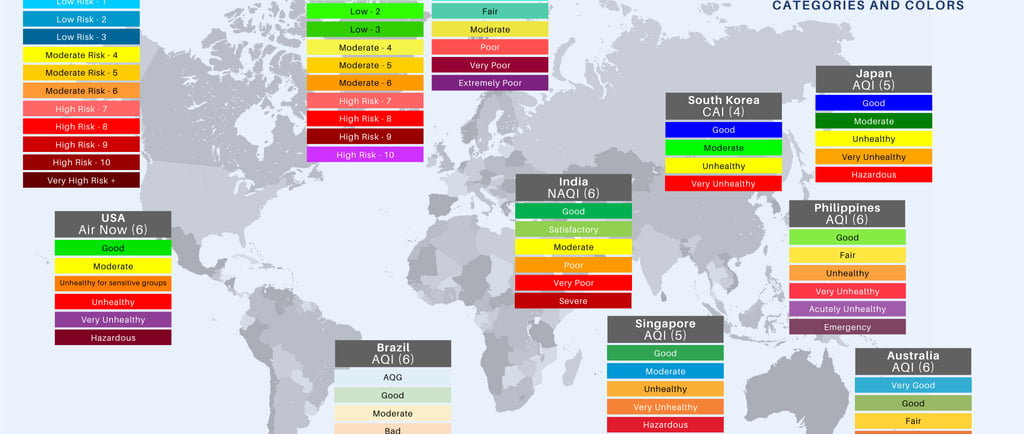Navigating the World of Air Quality Indexes and Hidden Pollutants
Catch a Breath: Explore the intricate world of Air Quality Indexes and their impact on your health. From understanding the complexities of AQI calculation to comparing global standards, embark on a journey to uncover the hidden pollutants affecting your environment. Join us in championing cleaner air for a healthier tomorrow.
CO2AIR QUALITY INDEXAIR POLLUTION
by: Lime
2/16/20243 min read


Breath of Fresh Air: Navigating the World of Air Quality Indexes and Hidden Pollutants
Introduction
Did you know that air pollution is responsible for an estimated 7 million premature deaths worldwide every year? The quality of the air we breathe profoundly impacts our health and well-being. As we navigate modern life, from bustling cities to tranquil countryside, the invisible threat of air pollution affects us all, regardless of our location or socioeconomic status.
In recent years, global awareness of the health impacts of air pollution has surged. The Air Quality Index (AQI) has emerged as a critical tool for monitoring and communicating air quality levels. This blog aims to delve into the concept of AQI, exploring its significance, calculation methods, and the diverse approaches taken by nations worldwide to assess and communicate air quality levels
Health Impacts of Poor Air Quality
Poor air quality poses severe health risks, ranging from respiratory problems to cardiovascular diseases and premature death.
Outdoor pollutants such as particulate matter (PM), ozone (O3), nitrogen dioxide (NO2), sulfur dioxide (SO2), and volatile organic compounds (VOCs) are major contributors to poor air quality.
Particulate matter, for instance, consists of tiny particles suspended in the air that can penetrate deep into the lungs, causing respiratory issues.
Ozone, a major component of smog, irritates the respiratory tract and worsens existing lung conditions.
Nitrogen dioxide and sulfur dioxide, primarily emitted from vehicles and industrial sources, exacerbate respiratory illnesses such as bronchitis and asthma.
VOCs, emitted from various sources including vehicle emissions, industrial processes, and household products, also contribute to respiratory problems and other health issues.
Indoor air quality (IAQ) is equally important. Elevated levels of carbon dioxide (CO2) indoors can lead to headaches, dizziness, and impaired cognitive function. Vulnerable populations, including children, the elderly, and individuals with pre-existing health conditions, are particularly at risk from both outdoor and indoor air pollution.
Understanding the Complexity of Air Quality Index (AQI)
In The calculation of the Air Quality Index (AQI) is a multifaceted process, integral to conveying air quality information accurately to the public. Across different nations, methodologies for determining AQI vary significantly, reflecting diverse environmental contexts, health priorities, and regulatory frameworks.
Each country adopts its approach, considering specific pollutants such as particulate matter (PM2.5 and PM10), ozone (O3), nitrogen dioxide (NO2), sulfur dioxide (SO2), and carbon monoxide (CO) in varying capacities.
The complexity of AQI calculation extends beyond pollutant selection to include the categorization of AQI values into distinct health risk levels. While some countries employ straightforward systems with fewer categories, others utilize more nuanced approaches to capture the spectrum of pollution severity comprehensively.
Amidst this diversity, the World Health Organization (WHO) serves as a guiding force, advocating for standardized methodologies and offering recommendations for AQI interpretation. Emphasizing the importance of considering multiple pollutants and their health impacts, the WHO strives to ensure that air quality information is accessible, consistent, and actionable on a global scale.
Stakeholders in air quality management must remain abreast of evolving methodologies and WHO guidelines, as our understanding of air pollution and its health effects continues to evolve.
AQI Systems Comparison
Navigating the diverse AQI systems worldwide can be challenging due to variations in standards and categorization. From shades of blue promising fresh air to hues of brown indicating poor quality, AQI color schemes vary widely. Our comparative analysis aims to shed light on these intricacies, empowering readers to make informed decisions about their health and well-being.
Embracing Clean Air: A Breath of Hope
As we uncovered the intricacies of air quality indexes and the pollutants lurking in our surroundings, one thing becomes crystal clear: the importance of clean air for our well-being cannot be overstated. Clean air is fundamental to our health and vitality, and it's a goal worth striving for.
Let's paint a picture of a world where every breath rejuvenates, where crisp air fills our lungs and fuels our vitality. It's a world within reach, where collective action and individual choices converge to create a healthier tomorrow.
Photo credit: Unsplash, By Olga Nayda
So, let's band together, armed with knowledge and determination, to champion cleaner air for all. With every decision, every advocacy effort, and every mindful action, we inch closer to this vision of a brighter, fresher future.
The journey may be long, but the destination—a world where clean air is a birthright—is worth every step. Let's embrace this opportunity to breathe easier and pave the way for generations to come.
Together, we can turn the tide and make clean air a reality for everyone. Let's do it.
Some Interesting Links:
WHO - Air Pollution Data Portal




Contact us
+ 63 915 619 4031
info@techcdoasia.com
Address
Cagayan De Oro City | Philippines
Business Details
TECH CDO ASIA
COMPANY REG. NO. <coming soon>
COMPANY TIN <coming soon>
